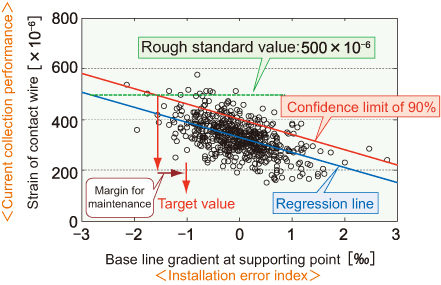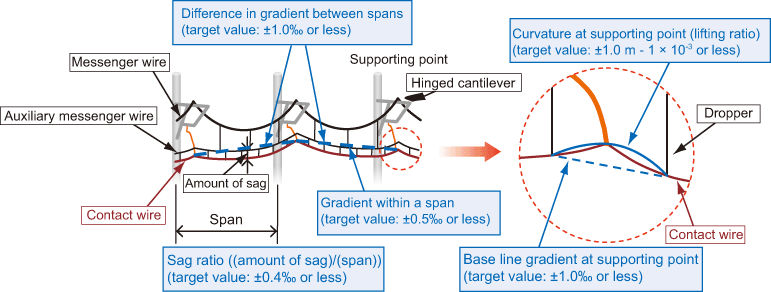4. Installation guidelines for overhead contact lines suitable for high-speed Shinkansen operations
- RTRI proposed a new standard (installation guidelines) for overhead contact line installation for high-speed stable current collection even beyond 300 km/h.
Horizontal installation of wires at a constant height is the ideal scenario for overhead contact lines, but in reality installation errors occur that significantly affect the current collection performance for such lines and pantograph systems. However, there has been little study/investigation regarding the allowable range of installation error for high-speed operations. Accordingly, RTRI proposed a new standard (installation guidelines) for overhead contact lines to ensure stable current collection even in high-speed operations at speeds exceeding 300 km/h.
The first step in drafting these installation guidelines, was to set the various sources of contact wire height installation error such as gradient, curvature, etc. for each position as evaluation targets. Next, dynamic simulations were performed based on actual measured data of contact wire height on a high-speed Shinkansen section. From the results, their relation to current collection performance (i.e., the amount of lifting at support points and the amount of strain on contact wire, contact loss, etc.) was statistically analyzed. Evaluation targets with a strong correlation were then selected to create an installation error index, the purpose of which is to set it so that current collection performance stays within a rough range of standard values to ensure satisfactory running, thereby defining/establishing a set of installation guidelines (Fig. 1). As an example of the index for installation errors in the installation guidelines and target values, values corresponding to a running speed of 300 km/h are shown in Fig. 2. Using a similar technique, installation guidelines corresponding to further increases in speed can also be compiled. Controlling installation errors according to these guidelines, opens the way to more favorable current collection performance in high-speed Shinkansen operations.
 Fig. 1 Example of correlation between the installation error index and current collection performance
Fig. 1 Example of correlation between the installation error index and current collection performance Fig. 2 Installation error index and target values (example of 300 km/h)
Fig. 2 Installation error index and target values (example of 300 km/h)